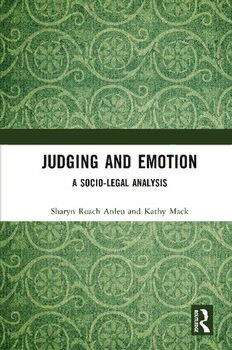
Judging and Emotion PDF
Preview Judging and Emotion
Judging and Emotion Judging and Emotion investigates how judicial officers understand, experience, display, manage and deploy emotions in their everyday work, in light of their fundamental commitment to impartiality. Judging and Emotion challenges the conventional assumption that emotion is inherently unpredictable, stressful or a personal quality inconsistent with impartiality. Extensive empirical research with Australian judicial officers demonstrates the ways emotion, emotional capacities and emotion work are integral to judicial practice. Judging and Emotion articulates a broader conception of emotion, as a social practice emerging from interaction, and demonstrates how judicial officers undertake emotion work and use emotion as a resource to achieve impartiality. A key insight is that institutional requirements, including conceptions of impartiality as dispassion, do not completely determine the emotion dimensions of judicial work. Through their everyday work, judicial officers construct and maintain the boundaries of an impartial judicial role which necessarily incorporates emotion and emotion work. Building on a growing interest in emotion in law and social sciences, this book will be of considerable importance to socio-legal scholars, sociologists, the judiciary, legal practitioners and all users of the courts. Sharyn Roach Anleu is Matthew Flinders Distinguished Professor, Judicial Research Project, College of Humanities, Arts and Social Sciences at Flinders University, Adelaide, Australia. Kathy Mack is Emerita Professor of Law, Judicial Research Project, College of Business, Government and Law at Flinders University, Adelaide, Australia. Judging and Emotion A Socio-Legal Analysis Sharyn Roach Anleu and Kathy Mack First published 2021 by Routledge 2 Park Square, Milton Park, Abingdon, Oxon OX14 4RN and by Routledge 52 Vanderbilt Avenue, New York, NY 10017 Routledge is an imprint of the Taylor & Francis Group, an informa business © 2021 Sharyn Roach Anleu and Kathy Mack The right of Sharyn Roach Anleu and Kathy Mack to be identified as authors of this work has been asserted by them in accordance with sections 77 and 78 of the Copyright, Designs and Patents Act 1988. All rights reserved. No part of this book may be reprinted or reproduced or utilised in any form or by any electronic, mechanical, or other means, now known or hereafter invented, including photocopying and recording, or in any information storage or retrieval system, without permission in writing from the publishers. Trademark notice: Product or corporate names may be trademarks or registered trademarks, and are used only for identification and explanation without intent to infringe. British Library Cataloguing-in-Publication Data A catalogue record for this book is available from the British Library Library of Congress Cataloging-in-Publication Data A catalog record has been requested for this book ISBN: 978-1-138-89302-3 (hbk) ISBN: 978-1-315-18004-5 (ebk) Typeset in Times New Roman by MPS Limited, Dehradun Contents List of illustrations ix Preface x Glossary xv 1 Introduction 1 Introduction 1 Judges and judging 2 Conceptualising emotion 4 Emotion as social practice 6 Emotion work and feeling rules 8 Emotion work and professions 10 Judging, emotion and emotion work 12 Outline of chapters 14 Researching emotion 17 2 Emotion and everyday judicial work: the context 27 Introduction 27 Court organisation 27 Everyday work 30 Case volume, time pressure and unpredictability 31 Court design and (in)formality 32 Court and trial participants 33 Parties, litigants and criminal defendants 34 Unrepresented litigants 35 Witnesses 36 Jurors 37 Legal representatives 38 Highest courts and appeals 39 vi Contents Sentencing 40 Case types 42 Sexual assault 42 Domestic/family violence 43 Childrens/youth 44 Civil and small claims 45 Coroners 46 Family law 46 Migration and refugee 47 Conclusion 48 3 Judicial impartiality, emotion and empathy 61 Introduction 61 Impartiality 62 Judicial impartiality in practice 63 The judicial oath 64 Keeping an open mind 65 Putting aside bias and emotion 67 Empathy and judging 70 Empathy in judicial practice: empirical findings 72 Impartiality and empathy 74 Judicial tears 76 Compassion 77 Conclusion 82 4 Judicial emotion: experience, display and management 88 Introduction 88 Judicial emotion experience 89 Interaction with legal representatives 91 Kinds of decisions 94 Judicial emotion display 98 Neutral display and dispassion 99 Deep and surface acting 101 Judicial emotion and judicial authority 102 Judicial emotion self-management 104 Self-talk 105 Adjournment 106 Contents vii Debrief 108 Humour 109 Work-family boundaries 111 Organisational emotion management 114 Conclusion 117 5 Judicial emotion work: others’ emotions 123 Introduction 123 Anticipate, predict, avert emotion 126 Awareness of participants or circumstances 126 Interpersonal approaches and resources 130 Court formality and civility 134 Allow expression of emotion 135 Types of participants 136 Sentencing and remorse 139 Judicial management after a participant’s emotion display 143 Articulating formal procedures and feeling rules 143 Taking breaks 146 Use own emotion or demeanour 147 Other resources 149 Conclusion 151 6 Professional regulation of judicial emotion 156 Introduction 156 Guidelines and codes 157 Judicial conduct complaints and discipline 159 Australia 161 England and Wales 165 United States of America 167 Fair hearing: judicial emotion and conduct 169 Judicial performance evaluation 172 Other professional guidance 174 Judicial education 175 Benchbooks 177 Judicial writing and speeches 177 Role models, shared experience and court culture 178 Conclusion 180 viii Contents 7 Conclusion 190 Introduction 190 Judicial perception and experience of emotion 190 Judging and emotion work 191 Self-talk 191 Demeanour 192 Humour 193 Other resources 193 Empathy 194 Emotion work: interconnections and boundaries 195 Feeling rules and regulation 195 Emotion work, gender and judging 196 Conclusion 198 Appendix: research design and data 202 Index 209 Illustrations Figures 3.1 Magistrates’ and judges’ assessment of empathy by gender 3.2 Magistrates’ and judges’ assessment of compassion by gender Table 6.1 Resolution of complaints about judicial officers: New South Wales, July 2011 to June 2019
